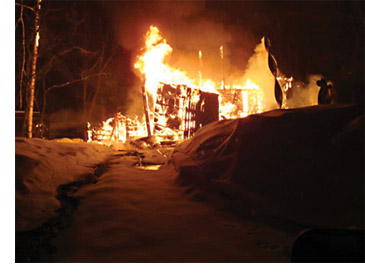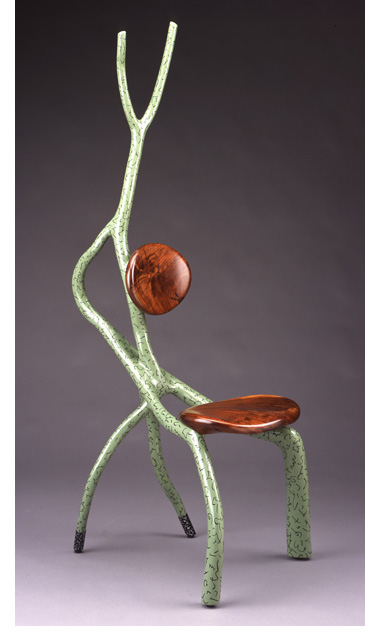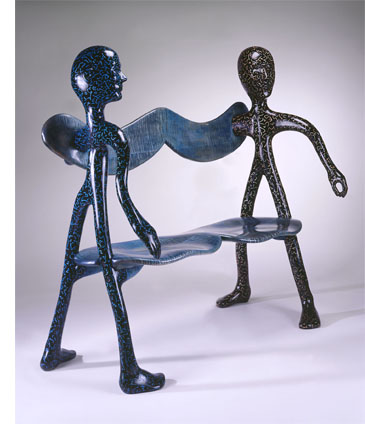Jon Brooks: On Fire
 Heavy snow fell the night of January 17, 2010, but when sculptural furniture maker Jon Brooks shut his eyes, he felt good about the day. He’d completed a commission for a new client—given it that last coat of paint. Andrew Spahr, from the Currier Museum of Art, had stopped by to discuss his upcoming retrospective—the artist’s first. While there, Spahr, the museum’s director of collections and exhibitions, dropped off Brooks’s portfolios and sketchbooks and took a look at his new work. He had sixteen completed works and twenty underway.
Heavy snow fell the night of January 17, 2010, but when sculptural furniture maker Jon Brooks shut his eyes, he felt good about the day. He’d completed a commission for a new client—given it that last coat of paint. Andrew Spahr, from the Currier Museum of Art, had stopped by to discuss his upcoming retrospective—the artist’s first. While there, Spahr, the museum’s director of collections and exhibitions, dropped off Brooks’s portfolios and sketchbooks and took a look at his new work. He had sixteen completed works and twenty underway.
Brooks slept in peace until 3:30 a.m. Then his wife Jami heard a pop. She elbowed Brooks. “What’s that?”
The artist sat up. When he looked out from their loft bedroom, he saw an orange glow in the living room. Kids, he thought. Sometimes they pranked the couple by shining flashlights in the windows. Brooks scurried down the ladder, and then saw, through the window, his studio engulfed in flames.
Fire engines arrived, but Brooks didn’t greet them. He knelt in the snowy fields, beating the ground with his fists, shouting, “No. No. Don’t take this away from me.”
It’s hard to picture this if you know anything about Brooks. He’s an easy-going man with a quick smile and a Zen-like spirit who daily walks his 188 acres of woods, searching for knobby limbs and branches—ones he can fashion into winged dogs or dancing legs. He draws inspiration from nature. Wearing a crocheted skull cap and brown T-shirt with bleach spots, he’s one of the free-spirits leftover from the 1960s—back to nature, doing for yourself, living off the land.
 Ironically, he’s also a man who needs to be in control, even describing himself as slightly obsessive. In his new studio, Brooks keeps his tools in tidy rows. A chair in progress dangles from the ceiling. On the legs, Brooks makes tiny pencil notations showing exactly how the pieces fit together. In his old studio, which he heated with a wood stove, he’d check and recheck the fire, and then check it again in the middle of the night, because he feared fire—his “worst nightmare.” In part, this is what makes this tragedy so incomprehensible and unfair.
Ironically, he’s also a man who needs to be in control, even describing himself as slightly obsessive. In his new studio, Brooks keeps his tools in tidy rows. A chair in progress dangles from the ceiling. On the legs, Brooks makes tiny pencil notations showing exactly how the pieces fit together. In his old studio, which he heated with a wood stove, he’d check and recheck the fire, and then check it again in the middle of the night, because he feared fire—his “worst nightmare.” In part, this is what makes this tragedy so incomprehensible and unfair.
“I lost my mind completely,” Brooks says about his initial reaction. “That was my howl. It was one of those internal things that you don’t give any thought to—a guttural response to a horrific loss.”
Horrific it was. He lost everything: tools, sketchbooks, portfolios, jigs, patterns, and wood that he’d collected. Most of all, though, he lost his studio—a soulful place, handmade, resembling something like a fairytale gingerbread castle, but rounded, as if growing out of the ground, like a mushroom.
“It’s like losing a close friend or a relative,” says Brooks. “In a sense it’s different because it’s material stuff. Because I had built the studio from the ground up, I knew every nail and every beam. I’d just finished the new addition and was just about to move in—poof, gone.”
The morning after the fire, Brooks sifted through the ashes. He couldn’t find a single usable tool. He found the two-person saw he’d used as a kid, but the handles were burnt off, the blade warped. He saved it—but that was about it. Distraught and deeply discouraged, he thought right then, “Either this ship is going down or you’ve got to pull yourself together.”
Brooks loved his work. So he contacted his insurance agent with a list of tools. Second blow: none of his tools were covered. In fact, insurance covered none of the contents—the most valuable part of his work. The rider on his homeowner’s insurance covered only the building. No one ever told him that he really needed a business policy. He sunk into deeper despair.
“I’d heard his insurance wasn’t working out,” says Jenna Goldberg, a friend and fellow furniture maker, who lives in Fall River, Massachusetts. She sent out an e-blast to everyone she knew. “It’s a big enough community that everyone can send $50 or tools.”
What happened next sounds like a scene from It’s a Wonderful Life. Neighbors brought by casseroles. Tools and checks arrived in packages from all over the world. The New Hampshire Furniture Masters (of which Brooks is a founding member) hosted a benefit. Then, one month after the fire, fifty-five people showed up at Brooks’s home. In two days, they built the artist a new studio—at no cost to him.
“It was a gift from heaven,” says Brooks.
Les Snow from the Craft Emergency Relief Fund (CERF) drove down from his Montpelier, Vermont office and gave Brooks a $1,500 check, plus a band saw donated by Black & Decker.
“What we’re able to provide is just a fraction of what [craftspeople] really need,” says Snow, CERF’s operations and financial services manager. “Still it’s a lift for them to know the craft community values what they do.” CERF provides emergency assistance to craftspeople nationally and educates them in ways to prevent and minimize loss.
But, as Brooks discovered, even the most careful craftsperson can lose everything. In his case, heavy snow had pulled a wire from the transformer, shooting sparks over his wood-shingled studio. He now advises artists: check your insurance—now.
In late February 2010, Brooks began making art again. “As an artist I’ve always responded by telling my story allegorically,” Brooks says, realizing he’d need to work out the fire in his art.
His first work reflected the morning after the blaze. When the sun rose, he saw two spiral pillars that had stood fifty feet from the studio, burned on the sides that faced the heat. Morning After the Fire is a sculptural work, consisting of two toppled, scorched pillars leaning against what looks like a watermelon-sized seedpod. The surface texture is coarse, cut with a chainsaw.

It’s darker than one expects to see from Brooks, who’s recognized not only for his fine craftsmanship and complex wood joinery, but also for his playful spirit. He creates wavy ladder-back chairs (some without seats), polka-dotted stick dogs, Georgia and Alfred (for Georgia O’Keeffe and Alfred Stieglitz), and his own brand of hieroglyphics, seemingly dashed over silky-smooth finishes.
“I think it has been important for me to realize that I’ve gone through this horrible loss that has been catastrophic in my life,” says Brooks. “But at the same time, I want to use it as a springboard to catapult me potentially in a new direction.”
 Texture takes a bigger role in his work now. He uses a rasp (a coarse file)—one of the unexpected gifts sent to him. When he first opened it, he said, “You’ve got to be kidding.” But when he tried it, he liked the scratched and scarred results. “It’s a reflection of what I’ve been through. I’ve been through the meat grinder of life.”
Texture takes a bigger role in his work now. He uses a rasp (a coarse file)—one of the unexpected gifts sent to him. When he first opened it, he said, “You’ve got to be kidding.” But when he tried it, he liked the scratched and scarred results. “It’s a reflection of what I’ve been through. I’ve been through the meat grinder of life.”
Using the rasp, Brooks abraded the legs of a chair he finished just three days before the opening of his Currier Museum retrospective. Mouvinon is a wide chair with a golden seat made from a beautifully textured quilted maple. The yellows emerge out of a crosshatch of dark marks, informed by the countless hikes Brooks has made deep in the forest, hidden by the shadows, but then dazzled by breaking light. It’s allegorical, yet metaphorical.
A year ago, Jon Brooks: A Collaboration with Nature (up now through June 13) seemed a tenuous exhibition. Brooks was so discouraged, lost so much. No one could have imagined how quickly family, acquaintances, and the studio furniture community mobilized to rescue their friend and colleague.
On the night of the museum opening, artists, gallery owners, friends, collectors, and museum curators crowded into the Currier. They formed a long line, which remained most of the night, to shake Brooks’s hand.
“These are my friends,” he says. “To be recipient of acts of this generosity is humbling. To whom a lot is given, much is expected. I feel more commitment to my work than ever. I’m on fire.”
_____________________________________________________________________________________________________________________
Debbie Hagan is editor-in-chief of Art New England. She also teaches creative writing at New Hampshire Institute of Art in Manchester, NH.
Read: Totally Tommy
